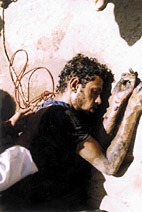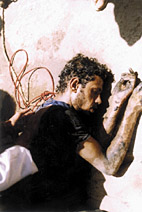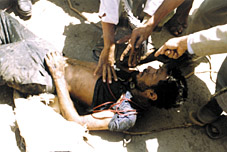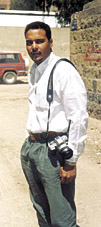
Yemen Times Special: A Miraculous Rescue Attempt Turns Successful In Hadda Street: Back to Life after Death [Archives:1999/39/Reportage]
September 27 1999
Report by: Tawfeek M. Al-Sharaabi
Yemen Times

The person in the pictures was not run over by a fancy car that is the fashion these days, nor was he harshly beaten up. The pictures were not taken after an invasion or a military attack nor was the person a victim of an explosion or so.
The person whom you see is actually a mere Yemeni worker in the Water and Sanitation Authority. He was one of the many workers who are trying their uttermost to make ends meet. Such workers expose themselves to the difficulties and hardships of life, so that they can sustain a livelihood through these harsh and difficult times. They are enslaved to their work and in return they are given nothing that can be comparable to the risks they go through.
These pictures have been taken by coincidence after this man (on the right) fell into one of the cesspools while working in Hadda street last Wednesday, September 15th. It is worth mentioning that there were several reports lately about the falling of workers, and even normal citizens passing by into such weakly structured cesspools in Sanaa. This is mainly due to the weak structure of the cesspools ceilings which sometimes collapse resulting in the death and injury of the people who walk on it.

Not to get you so bored, here, we give you the actual story with the words of the courageous rescuer, the person who brought the worker back to life:
“My name is Ayman Al-Gabree, a petroleum engineer living on Hadda Street. I was sitting at my home at around 1:15 p.m. while all of a sudden, we heard a strong knocking at the door. My nephew Abdul Hameed went and opened the door and found someone asking for a glass of water in great panic. I went out and asked him what the matter was and he said that someone had fallen inside the swage cesspools. So I hurried to the kitchen and took a jug of water and brought my camera and run outside. The person was still inside the cesspools and everybody was staring in panic and could do nothing about it. Finally, one of the workers tied himself to a rope and then he managed to pull the victim out, however, it seemed that it was too late, for he was totally dead. There was no pulse in the neck, I could not feel any heart beats, and there were no signs of breathing. Soon, as in all such incidents in Yemen, there was a large crowd of curious people around the victim. I shouted at them to move away, for it was no time to cause panic, then I had some photos captured. Despite the large number of people staring, no one even thought of provided a single vehicle to take him to a hospital or so, as if they were watching a movie for fun. Then some responsible people asked “what shall we do?” Some said that we should take him to the hospital. I told them that by the time we get him to the hospital he would definitely be dead. “It would be too late. We should begin by giving him a first-aid. We should try our best to get the man’s consciousness back; so that his heart would pump and he he would breath again.” I said.

Mr. Ayman Algabree went on saying “To my dismay, I could see no equipment, tools, masks, uniforms that must be available while these people work. I can definitely tell you that, according to my experience, if this person stayed unconscious for five or ten more minutes, bringing him to life would have been impossible, or at least if he lived, he would have lived with a damaged brain, and live his life handicapped.”Asking him about his experience in the first aid, Mr. Ayman said that he was well-trained in France and that he is currently working in an oil field company in Al-Masila, in Hadramout.
This incident has actually raised a lot of questions, which need to be answered from the people in charge.

-Where are the special uniforms that workers should be provided with while working?
-Where are all the rescue tools that should be available all the time during the time during work?
-Where are the specialized rescue groups who should be present at the site in case something like this happens?
-Why aren’t these workers not trained how to give the first aid?
Finally, as the Yemen Times, we thank Mr. Ayman Algabree for his gesture to save the worker, and express our hope that the government would value his efforts, just as we do value them by thanking him and calling him to our office to give him a written letter of gratitude for his humane and invaluable efforts in saving a man’s life.
——
[archive-e:39-v:1999-y:1999-d:1999-09-27-p:./1999/iss39/report.htm]


